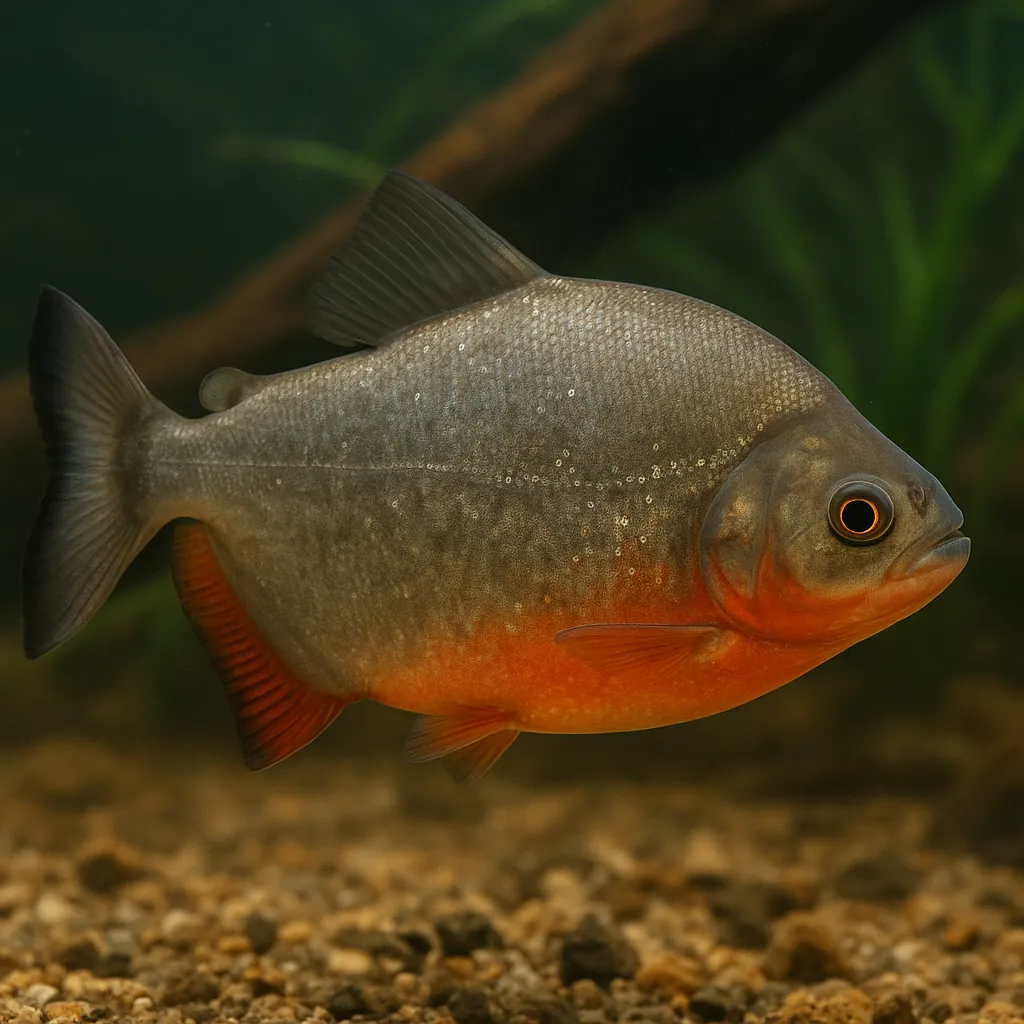
Red bellied pacu
Introduction
The Red Bellied Pacu (Piaractus brachypomus) is a captivating freshwater fish native to South America's Amazon and Orinoco river basins. Often mistaken for the Red Bellied Piranha due to their similar juvenile appearance, pacus are primarily herbivorous and can grow to impressive sizes, making them a unique addition to large home aquariums. However, their substantial size and specific care requirements mean they are best suited for experienced aquarists prepared to meet their needs.
What makes the Red Bellied Pacu appealing to aquarists?
Their striking appearance and peaceful nature, combined with their fascinating behaviors, make them a standout species for those equipped to provide the necessary environment.
Are Red Bellied Pacus suitable for beginner fishkeepers?
Due to their large size and specific care requirements, they are more appropriate for intermediate to advanced aquarists.
Care and Environment
Proper care for the Red Bellied Pacu involves meticulous attention to tank size, water parameters, diet, and tank setup.
What is the minimum tank size for a Red Bellied Pacu?
Given their potential to reach up to 60 cm (24 inches) in length, a minimum tank size of 250 gallons (approximately 946 liters) is recommended for a single adult pacu. For optimal conditions or housing multiple specimens, a tank of at least 500 gallons (approximately 1,892 liters) is advisable.
What are the ideal water parameters for Red Bellied Pacus?
Maintain a temperature between 23°C and 28°C (73°F to 82°F), a pH range of 4.8 to 7.5, and water hardness between 0 to 15 dGH.
How should the tank be set up for a Red Bellied Pacu?
Due to their size and activity level, provide ample open swimming space. Decorate with large, secure pieces of driftwood and rocks, ensuring they are too heavy to be moved. Avoid live plants, as pacus tend to consume them.
What filtration system is recommended for Red Bellied Pacus?
Use a robust filtration system capable of handling the significant waste produced by these large fish. A sump-type filter is ideal, as it allows most equipment to be located outside the tank, reducing the risk of damage from the pacu's active swimming.
What should be included in a Red Bellied Pacu's diet?
Offer a varied diet consisting of quality dried pellets or floating sticks, along with plenty of fruits and vegetables such as spinach, lettuce, apples, bananas, peaches, grapes, zucchini, peas, cabbage, and carrots.
Are there any specific challenges in keeping Red Bellied Pacus?
Yes, their rapid growth, large adult size, and substantial waste production require significant space and maintenance. Additionally, their tendency to eat live plants and potential to outgrow standard aquariums pose challenges for many hobbyists.
Origin and Habitat
Red Bellied Pacus are indigenous to the Amazon and Orinoco river basins in South America, encompassing countries like Colombia, Venezuela, Peru, Bolivia, and Brazil. They inhabit slow-moving rivers, floodplains, and lakes, often found in areas with dense vegetation and submerged structures. These environments provide ample food sources, including fruits, nuts, and seeds that fall into the water. Seasonal variations, such as flooding during the rainy season, influence their feeding and breeding behaviors.
How do seasonal changes affect Red Bellied Pacus in the wild?
Seasonal flooding expands their habitat, providing access to new food sources and breeding grounds, which are crucial for their life cycle.
What type of water bodies do Red Bellied Pacus prefer?
They favor slow-moving or still waters with abundant vegetation and submerged structures, offering both food and shelter.
Temperament and Compatibility
Red Bellied Pacus are generally peaceful but can become territorial as they mature. Juveniles often shoal, but adults tend to be more solitary. They can coexist with other large, peaceful fish such as arowanas, large cichlids, and sizable catfish. However, smaller fish may be at risk of being eaten due to the pacu's size and opportunistic feeding habits.
Can Red Bellied Pacus be kept with smaller fish?
It's not recommended, as smaller fish may be seen as prey, especially as the pacu grows larger.
Do Red Bellied Pacus require companions of their own species?
While juveniles may shoal, adults are more solitary. Keeping multiple adults together requires a significantly larger tank to prevent territorial disputes.
Interesting Facts
Red Bellied Pacus are often mistaken for piranhas due to their similar appearance, especially in juvenile stages. However, unlike the carnivorous piranha, pacus are primarily herbivorous. They possess human-like, square teeth adapted for crushing plant material. In the wild, they play a vital role in seed dispersal, contributing to the health of their ecosystems. Additionally, pacus have been known to live up to 25 years in captivity, making them a long-term commitment for aquarists.
Why do Red Bellied Pacus have human-like teeth?
Their square, molar-like teeth are adapted for crushing hard plant materials like seeds and nuts.
How long can Red Bellied Pacus live in captivity?
With proper care, they can live up to 25 years, making them a long-term commitment for aquarists.
Sources
All information in this article has been gathered from the following reputable sources:
Overview
Recommended Tank Size 499.8 Gallons (for optimal conditions or housing multiple specimens) |
Minimum Group Size 1 |
Minimum Tank Volume 249.9 Gallons |
Maximum Adult Length 23.6 inches |
Average Adult Length 19.7 inches |
Shoaling (6+ required) No |
Preferred Water Type Freshwater, soft to moderately hard, slightly acidic to neutral |
Temperature Range (°C) 23–28 |
pH Range 4.8–7.5 |
Water Hardness (dGH) 0–15 |
Typical Lifespan (years) 15 years |